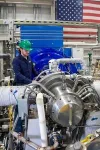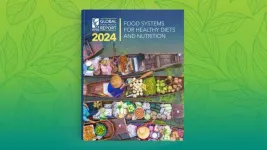(Press-News.org) The Swedish capital Stockholm aims to capture more carbon dioxide than is emitted by 2030. Therefore, the city is investing in new technology at a combined heat and power plant. But it is a strategy that has been adopted without sufficient discussion of the risks, says researchers at Linköping university, Sweden.
“Stockholm has a very ambitious climate policy. But there’s also been a kind of resignation. This new technology has appeared to offer the promise of a solution. And that’s perhaps why there’s been no critical discussion at all,” says researcher Alexander Olsson at the Department of Thematic Studies – Environmental Change at Linköping University.
The energy utility Stockholm Exergi is investing in new technology to capture carbon dioxide from the combined heat and power plant Värtaverket. Potentially, 800,000 tons could be removed per year and stored in the bedrock.
Since the heat and power plant is fired by biofuel, this would mean that carbon dioxide is removed from circulation. These so-called negative emissions can then be offset against other emissions that politicians deem impossible to remove. The end result would be that Stockholm’s net emissions would be zero or even negative. But there are many uncertainties.
Together with colleagues at the Department of Thematic Studies – Environmental Change, Alexander Olsson has interviewed thirteen politicians and officials in Stockholm to hear their reasoning about the opportunities and risks. They have also analysed debates held in the municipal council from 2015 to 2023. Their conclusions are presented in an article in Energy Research & Social Science.
One thing is clear, according to the researchers. Neither in interviews nor in the debate transcripts is there any serious questioning of the path set out to meet the climate targets, which are to a large extent based on substantial negative emissions at Värtaverket. There seems to be a lack of an alternative plan.
“This means that Stockholm’s climate targets are entirely dependent on this facility and the ability to store carbon dioxide. There is no plan B. it’s a very, very risky portfolio, to put it in financial terms,” says Alexander Olsson.
According to the researchers, the local decision-makers feel that much of climate policy and emissions is beyond their scope of influence. The thought of being able to make large amounts of carbon dioxide disappear through their own decisions thus appeals to the decision-makers. The opportunity to be at the forefront of technology and to be a role model for other cities is also appealing.
It is then tempting to ignore the fact that the technology may not work as intended or that implementation may be delayed. There are no ready-made solutions for how the carbon dioxide is to be transported and disposed of, or answers as to how large quantities can be taken care of. In addition, there are major environmental risks associated with the planned interim storage of carbon dioxide at the port of Värtahamnen close to the city. Almost none of this is mentioned in the interviews or in the debates.
In the light of the promise offered by the new technology, alternative measures risk appearing less important. For example, the researchers note that Stockholm’s previous initiative to use biochar to store carbon dioxide has been diminished. There is also a risk that the discussion about which emissions can be influenced locally will be forgotten.
For example, Stockholm wants to build a new plant for waste incineration. This would lead to increased carbon dioxide emissions, but it is not identified as a problem by the interviewed decision-makers, which may be due to the high hopes placed on capture at Värtaverket. It is easy to sit back, because the problem seems to be solved.
The researchers’ advice is to set separate targets for how much carbon dioxide is to be captured and how much emissions are to be reduced from waste incineration and traffic. They say that this would make clearer which measures work and which do not. The targets should also be complemented by a risk analysis that looks at the likelihood that a measure will be successful. This would bring to light the need for alternative methods.
“We don’t think things improve by not being critical. We believe that criticism is an important part of a democratic process, and that decisions will be better if there’s a broader debate,” says Alexander Olsson.
The study has been funded by the Swedish Energy Agency and Formas.
END
Risky path to meeting climate targets for Stockholm
2024-05-29
ELSE PRESS RELEASES FROM THIS DATE:
Longer freight trains have a higher risk of derailment, new study shows
2024-05-29
In February 2023, 38 cars from a 151-car, 9,300-foot-long freight train derailed in East Palestine, Ohio, leading to the release of hazardous materials that required the evacuation of more than 2,000 residents. In recent years, such longer and heavier freight trains have become more common, primarily driven by fuel efficiency, cost-savings, and emissions reduction measures in the railroad industry.
New research in the journal Risk Analysis has confirmed that longer freight trains bring with them a higher risk of derailment. The study found that a 100-car train is more than twice as likely to experience a derailment than ...
The 2024 Global Food Policy Report stresses urgent need for transformative action to achieve sustainable healthy diets and improved nutrition
2024-05-29
Washington DC, May 29, 2024: In the face of growing challenges posed by unhealthy diets, all forms of malnutrition, and environmental constraints, the 2024 Global Food Policy Report (GFPR) — released today by the International Food Policy Research Institute (IFPRI) — underscores the importance of transforming complex global food systems to ensure sustainable healthy diets for all.
Progress in reducing undernutrition and micronutrient deficiencies has slowed in low- and middle-income countries, while overweight and obesity has rapidly increased worldwide. Many countries ...
Electrochromic films — like sunglasses for your windows?
2024-05-29
Advances in electrochromic coatings may bring us closer to environmentally friendly ways to keep inside spaces cool. Like eyeglasses that darken to provide sun protection, the optical properties of these transparent films can be tuned with electricity to block out solar heat and light. Now, researchers in ACS Energy Letters report demonstrating a new electrochromic film design based on metal-organic frameworks (MOFs) that quickly and reliably switch from transparent to glare-diminishing green to thermal-insulating red.
Hongbo Xu and colleagues used MOFs in their electrochromic film because of the crystalline substances’ abilities to form thin ...
Chocolate’s tasty flavors might pose a risk in other desserts
2024-05-29
What makes chocolate taste and smell so delicious? Chemistry, of course! A variety of molecules work together to create that unmistakable aroma, but those same molecules might carry some unwanted health effects if there are too many around. According to research published in ACS’ Journal of Agricultural and Food Chemistry, while many of the compounds appeared in chocolate in low enough concentrations to be safe, higher amounts were found in some baked sweet treats.
When making chocolate, cocoa beans are roasted to help their chocolatey flavors shine. During this process, new molecules ...
The New York Academy of Sciences and the Leon Levy Foundation Announce the 2024 Leon Levy Scholars in Neuroscience
2024-05-29
New York, NY, May 29, 2024 — The New York Academy of Sciences and the Leon Levy Foundation announced today the 2024 cohort of Leon Levy Scholars in Neuroscience, continuing a program initiated by the Foundation in 2009 that has supported 170 fellows in neuroscience.
This highly regarded postdoctoral program supports exceptional young researchers across the five boroughs of New York City as they pursue innovative neuroscience research and advance their careers toward becoming independent principal investigators. Nine scholars were competitively selected for a three-year term from a broad pool of applications from more than a dozen ...
The once-welcomed Rohingya refugees now face hostility from the hosts in Bangladesh
2024-05-29
The number of refugees has sharply increased in recent decades, reaching 37.8 million in 2022. Amidst this surge, host communities—locals residing in areas where refugee camps are situated—are also positively and negatively impacted by the refugee influxes. The negative impacts include competition over scarce resources and in the unskilled labor market. While the international media and aid organizations put the spotlight on assisting refugees, the challenges faced by host communities are frequently sidelined.
In 2017, over ...
Improving air quality increases forest fires
2024-05-29
If we want cleaner air, fewer forest fires, and less severe climate change, a new UC Riverside study shows we must reduce aerosol pollution and greenhouse gases like carbon dioxide at the same time.
The study found that boreal forests in the northern hemisphere are particularly vulnerable to negative effects of cleaning up aerosol pollution. This includes forests in Canada, Alaska, northern Europe, and northern Russia.
Aerosols are small particles like dust and sea salt as well as airborne chemicals produced by fossil fuel combustion. They are responsible for poor air quality. The UCR study, published in the journal ...
RNA inhibitor is shown safe and effective in reducing a wide range of cholesterol and triglyceride levels in the blood in Mount Sinai-led clinical trial
2024-05-29
A small interfering RNA (siRNA) investigational therapy that inhibits a gene involved in lipoprotein metabolism has been shown in a clinical trial led by Mount Sinai researchers to significantly reduce levels of different types of cholesterol and triglycerides in individuals with mixed hyperlipidemia, a condition in which fats build up in the blood.
In addition to seeing promising preliminary results related to safety and efficacy in clinical trials, the Mount Sinai researchers found the RNA interference (RNAi)-based therapy zodasiran to be a potentially promising option for substantially reducing a number of atherogenic lipoproteins while requiring less frequent ...
Our political debates may not be as antagonistic as we think, study shows
2024-05-29
Spend any time scrolling through social media or news sites and it feels like America is a nation in constant argument. Off-hand remarks often spark fierce screaming matches. Partisanship is up, Gallup tells us, while trust in institutions is down.
However, a new study co-authored by Berkeley Haas Assistant Professor Erica R. Bailey suggests this perception may not accurately reflect the nature and frequency of political debates among everyday Americans. In three studies involving nearly 3,000 participants, researchers found most debates ...
Imagined otherness: Why we dehumanize our political opponents
2024-05-29
By Dylan Walsh
Some of human history’s greatest atrocities—genocide, slavery, ethnic cleanings—are rooted in our ability to dehumanize people from other social, political, or cultural groups.
Whereas prior research has traced dehumanization to the belief that others think or feel less than we do, new research co-authored by Haas professor Sameer Srivastava shows that our tendency to dehumanize can also be influenced by how we think others view important facets of the world. The greater ...





